2019-2020 Statewide Highlights
MAINE FOOD SYSTEM |
Supporting Maine’s Wild Blueberries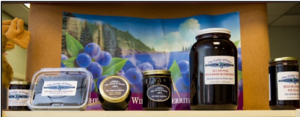
Relevance – Wild blueberries are a $250 million industry in Maine. Mummy berry and Botrytis flower blight can be serious diseases in wild blueberries that can greatly decrease yield when they occur. Mummy berry can result in complete crop loss if not effectively controlled. Botrytis can kill off 30% of flowers during bloom, and frost during bloom also can greatly decrease yield. Maine’s 510 blueberry growers need accurate weather and disease risk information, and those who use fungicides need timely information on when they should apply fungicides for optimum efficacy. Timely applications of fungicides provide improved control of mummy berry and Botrytis. Avoiding unnecessary fungicide applications also saves growers’ money and prevents adding unnecessary pesticides to the environment.
Response – Extension has a network of 15 Internet-connected weather stations in low bush blueberry fields. From the weather data and field conditions, we provide growers with biweekly reports on infection risk during mummy berry season and make recommendations on effective times for fungicide applications. In 2019, Extension provided growers with a new weather app developed with AgriNet. This web-based app is available on mobile phones and provides current information for each weather station, and indicates when disease events have occurred. Future additions to the app will include alerts for frost events and inclusion of growing degree day models for important blueberry life stages or pests.
Result – As a result, more growers can quickly obtain information about their fields for weather conditions and disease risks. Growers report substantial savings by avoiding unnecessary applications of fungicides to control mummy berry disease.
AgrAbility…Supporting Farmers of All Abilities To Remain Active on the Farm
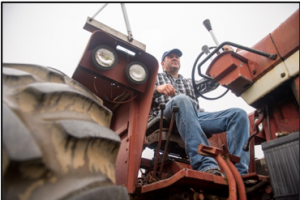 Relevance – The average U.S. farmer is 58 years old, and farming is the sixth most dangerous job in America. An estimated 5,700 farmers, farm family members, or farmworkers in Maine have a chronic health condition or disability, such as post-traumatic stress disorder, traumatic brain injury, or aging-related issues, such as arthritis or hearing loss. In addition to farmers, fishermen, forest workers, and migrant workers face similar challenges for remaining successful in production agriculture.
Relevance – The average U.S. farmer is 58 years old, and farming is the sixth most dangerous job in America. An estimated 5,700 farmers, farm family members, or farmworkers in Maine have a chronic health condition or disability, such as post-traumatic stress disorder, traumatic brain injury, or aging-related issues, such as arthritis or hearing loss. In addition to farmers, fishermen, forest workers, and migrant workers face similar challenges for remaining successful in production agriculture.
Response – Funded through USDA/NIFA, Maine AgrAbility helps Maine farmers, loggers, and fishermen facing physical or cognitive challenges, to enhance their ability to farm and live independently, which improves their quality of life and economic sustainability. AgrAbility specialists assess issues and offer adaptive recommendations. They provide education about safe work methods and connect people with other resources through this nonprofit partnership between Extension and Alpha One. The program supports the capacity of health and agricultural professionals to provide assistance and services for farmers and farmworkers with disabilities.
Result – Since the project began in 2010, Maine AgrAbility has provided technical information to over 800 farmers and conducted on-site assessments for over 100 agricultural workers. The diverse agricultural operations include dairy and livestock operations, Christmas tree farms, fruit orchards, agritourism, vegetable, and maple syrup production, hay sales, managing woodlots, and lobstering. A 2019 program evaluation suggests that participants experienced an increase in economic viability and sustainability and that AgrAbility suggestions made their farm business more accessible, or using their existing resources differently allowed them to start building up their farm again into a viable and stronger business.
Protecting Maine’s Dairy Industry
Relevance – Maine currently has 8,200 farms, and many have dairy animals. Maine’s dairy industry generates more than $570 million a year for the state’s economy and contributes more than $25 million in state and municipal taxes. Dairy farms employ more than 1,300 people statewide, and the industry provides more than 4,000 jobs for Maine people. As well, organic and small ruminant dairies are producing a diverse collection of artisanal cheeses and alternative milk products. For public safety and quality control reasons, all dairy producers must keep pathogenic bacteria out of their dairy animals and their dairy products. It is important for them to identify and cull these chronically infected animals to protect the public, and to avoid spreading this disease on their dairies.
Response – The UMaine Veterinary Diagnostic Laboratory (VDL) offers a local, responsive resource  for culturing milk samples (bulk tank or individual animal samples), along with water samples, thus providing a key piece of information for producers, Extension staff, and milk processors. The VDL helps protect Maine’s dairies, both large and small. In 2019 cultured over 1,600 milk samples for mastitis.
for culturing milk samples (bulk tank or individual animal samples), along with water samples, thus providing a key piece of information for producers, Extension staff, and milk processors. The VDL helps protect Maine’s dairies, both large and small. In 2019 cultured over 1,600 milk samples for mastitis.
Result – Effective responses to animal illnesses are only possible when the disease is identified. Maine’s dairy owners benefit from local, responsive mastitis diagnostic services. At the VDL, Extension staff screen both large and small dairies for mycoplasma, one of the most problematic pathogens for producers of milk or beef. Farmers avoid antibiotic use by culling animals with incurable infections, such as Staphylococcus aureus or Mycoplasma Bovis. This protects public health, jobs, and this sector of the state’s economy.
4-H YOUTH DEVELOPMENT |
Fostering Positive Science Identities in Youth
Relevance – Educators in the United States, and in Maine, are continuing to work toward fostering interest and positive science identities in youth. They are also searching for ways to engage youth in local, place-based STEM activities while using best practices for science learning and meeting local state, and national standards. Youth enjoy and learn from experiential learning activities, particularly activities that have local and personal relevance and applicability. University researchers continue to explore ways to communicate research to public audiences, including K-12 age youth.
Response – As a way to bring UMaine research to youth audiences, Extension in 2014 developed 4-H Science Toolkits – curricula with associated materials available for loan from Extension offices. These toolkits are available to formal and informal educators at no cost, and the curriculum can be downloaded online. New toolkits have been recently developed or are being developed in mineralogy, meteorites, data science, forestry, solar energy, and aquaculture. Toolkits are standardized so that each serves a classroom group of 25 youth.
Result – The toolkit lending library has nearly 200 individual kits in almost 50 unique STEM subjects. In 2019, over 150 adults borrowed the 4-H Science/STEM toolkits, reaching over 2,000 youth with free hands-on STEM learning. This number is expected to grow with the availability of new toolkits and their use by 4-H STEM Ambassadors, UMaine researchers, and with many faculty adding funding for the creation of 4-H toolkits to their grant proposals. Outside sponsors have also sponsored 4-H toolkits, and the program is also part of a $20 million National Science Foundation grant to UMaine. By reducing a significant barrier for 4-H volunteers, club leaders, 4-H staff, and other educators, these STEM toolkits are bolstering STEM learning to Maine youth.
Childhood Obesity and EFNEP
Relevance – Nationally, 4.8 million (15.5%) children aged 10 to 17 are obese. Comparatively, Maine’s youth obesity rate is similar to the national rates at 14.9%. Annually, the United States spends $14 billion to treat childhood obesity, and obese children are almost three times more expensive for the 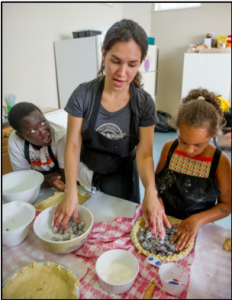 health system than the normal weight child. Rising childhood obesity rates will continue to put a strain on current health promotion programs and continue to raise health care costs for the nation.
health system than the normal weight child. Rising childhood obesity rates will continue to put a strain on current health promotion programs and continue to raise health care costs for the nation.
Response – In an effort to stop rising childhood obesity rates, UMaine Extension EFNEP implements direct education to Maine’s low-income children to improve their knowledge, behaviors, and attitudes related to improving diet quality, increasing daily physical activity, and using food resources management practices to learn how to plan and shop for healthy meals and snacks. Program outcomes are measured for all youth ages 5-18 using validated pre/post program surveys.
Result – In 2019, 2,056 youth participated in Maine EFNEP. Youth participated in an average of 6 classes over 2 months. Of the 2,056 youth that participated in EFNEP, 1,936 completed a pre and post-survey. As a result of participating in EFNEP:
- 77% of youth improved their abilities to choose foods according to current Dietary Guidelines or improved nutrition knowledge.
- 38% of youth improved their daily physical activity practices.
- 53% of youth used safe food handling practices more often.
- 46% of youth improved their ability to prepare simple, nutritious, affordable food.
COMMUNITY AND ECONOMIC DEVELOPMENT |
Maine Harvest for Hunger: Mobilizing to Support Food Insecure Citizens
Maine has the highest rate of food insecurity in New England, and ranks 12th in the U.S. The USDA estimates 13.6 percent of Maine households, over 182,000 individuals, are food insecure. Twenty percent of children are food insecure. Twenty-three percent of seniors have marginal, low, or very low food security. Thirty-seven percent of food-insecure people do not qualify for food stamps or other government programs. It is especially challenging for food-insecure people to afford high quality, fresh, nutritious food, and donations of fresh produce to Maine’s emergency food system has declined significantly in recent years.
Since 2000, UMaine Extension’s Maine Harvest for Hunger (MHH) program has mobilized gardeners, 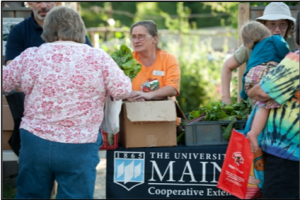 farmers, businesses, schools, and civic groups to grow, glean, and donate quality produce to distribution sites (pantries, shelters, community meals) and directly to neighbors in need, to mitigate hunger, improve nutrition and health, and help recipients develop lifelong positive nutritional habits. In addition, educational programs such as Hancock County’s Eat Well Volunteers, have focused on engaging food pantry recipients in learning appropriate methods of cooking and using fresh produce, and state-wide Extension programs help teach Mainers to grow more of their own fresh garden produce.
farmers, businesses, schools, and civic groups to grow, glean, and donate quality produce to distribution sites (pantries, shelters, community meals) and directly to neighbors in need, to mitigate hunger, improve nutrition and health, and help recipients develop lifelong positive nutritional habits. In addition, educational programs such as Hancock County’s Eat Well Volunteers, have focused on engaging food pantry recipients in learning appropriate methods of cooking and using fresh produce, and state-wide Extension programs help teach Mainers to grow more of their own fresh garden produce.
Since 2000, MHH participants have distributed over 3 million lbs. of food to citizens grappling with hunger. In 2019, donations of over 193,000 lbs. of fresh produce from over 120 Maine farms went to 207 hunger alleviation distribution sites. A corps of 365 volunteers and 8 corporate partners from 12 counties logged over 6,000 hours, and the value of the produce is estimated at over $327,000. Now in its 20th season, MHH has continued to improve the efficiency of supplying fresh produce to food pantries across Maine through building partnerships. For example, through MHH volunteer planning and communications, several food pantries are now sending trucks and vans directly to the farm where gleaning is taking place.
Maine has approximately 130 community gardens and many of them are supported by Extension staff and Master Gardener Volunteers. As a result, more than 30 of them now have added an MHH area to their community garden and have contributed almost 20,000 lbs. of our 2019 totals. In Penobscot County, volunteers anonymously sponsor food, insecure families, by collaborating with the Maine Family Institute to distribute fresh produce to the families, which has resulted in their increased consumption of fresh fruit and vegetables.
Signs of the Seasons: A New England Phenology Program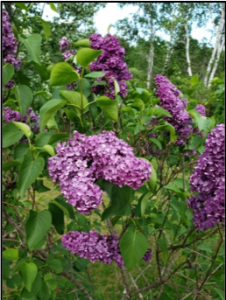
Relevance – Average New England air temperature increases are among the highest in the continental United States, and sea surface temperatures in the Gulf of Maine have increased faster than 99 percent of the rest of the world’s oceans. Little is known about how marine and upland biota respond to these environmental changes. Climate scientists, resource managers, economists, and others need reliable information about the effects of climate change, and the process of collecting phenology data is a simple, reliable method to ground-truth climate models and understand local-scale biological changes.
Response – Since 2010, UMaine Extension and Maine Sea Grant have worked with state and regional partners to develop and coordinate Signs of the Seasons (SOS), a monitoring program that engages citizens of all ages in observing the timing of seasonal plant and animal life cycle events (phenology). The data are publicly available through the National Phenology Network, and the program offers climate and phenology seminars, webinars, and field-based learning opportunities for participants and the public throughout Maine and New Hampshire. SOS volunteers help scientists document the local effects of global climate change.
Result – In 2019, we trained 78 new adult volunteers, and hundreds of volunteer observers made more than 1,090 site visits and recorded over 43,000 observations of the program’s 22 indicator species in Maine and New Hampshire, including rockweed and common loon. Of participants surveyed, 72% reported an increase in their knowledge of climate science, 78% reported taking action regarding climate change and 88% reported a better understanding of phenology as an indicator for climate-related biological change. SOS continues volunteer engagement with increased K-12 programming, and through opportunities for species-specific research seminars
Online Presence
In 2019, UMaine Extension’s website at extension.umaine.edu – a composite of 58+ interconnected websites – received over 2.4 million page views. Nearly 37,000 followers followed or were subscribed to UMaine Extension’s 56 county and program-specific social media accounts on Facebook, Twitter, YouTube, Pinterest, and Instagram. More than 230 educational videos were available to visitors on our YouTube and Kaltura channels or embedded in our web pages. More than 2,700 clients used our online registration system to register for classes, workshops, events, and more.
The County Extension Act
The County Extension Act explains the role of county government in funding local Extension offices.
Cooperative Extension work shall consist of the giving of practical demonstrations in agriculture and natural resources, youth development, and home economics and community life and imparting information on those subjects through field demonstrations, publications, and otherwise. For the purpose of carrying out this chapter, there may be created in each county or combination of two counties within the State an organization known as a “county extension association,” and its services available to all residents of a county. The county extension is viewed as a unique and important educational program of county government. The executive committee of each county extension association shall prepare an annual budget as requested, showing in detail its estimate of the amount of money to be expended under this chapter within the county of counties for the fiscal year. The executive committee shall submit to the board of county commissioners on a date requested by the county commissioners, and the county commissioners may, if they deem it justifiable, adopt an appropriate budget for the county extension program and levy a tax therefore. The amount thus raised by direct taxation within any county or combination of counties for the purposes of this chapter shall be used for the salaries of clerks, provision of office space, supplies, equipment, postage, telephone, a contribution toward the salaries of county educators and such other expenses as necessary to maintain an effective county extension program.1
1Excerpted from Title 7, Chapter 7 of the Maine Revised Statutes, §191–§195.
Photos by: Donna Coffin, Sheila Norman, Emily Mott, Trisha Smith, Anette Moulton, Griffin Dill, Edwin Remsberg, and Holly Rutherford, Americorp Vista PR Food Center

